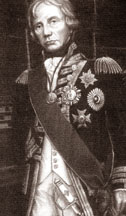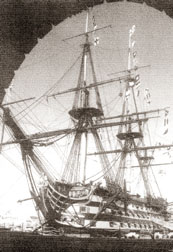|
DAILY NEWS ONLINE |
|
|
|
OTHER EDITIONS |
|
|
|
|
|
|
|
|
|
OTHER LINKS |
|
|
|
|
|
|
  |
Admiral Lord Nelson:Britain's Greatest Naval Hero
|
|
|
Admiral Lord Nelson was unquestionably Britain's greatest Naval hero and the most beloved Admiral. He is world renowned for his participation in the most famous Naval engagement in the British history and the most celebrated of all the battles at sea - the Battle of Trafalagar, where he lost his life 200 years ago on October 21, 1805.
He was slight in stature at 5'7", physically scarred by injuries sustained in battle but was an inspirational leader who created and nurtured his 'band of brothers' at sea. Decisive and unfaltering in battle, he nevertheless cared deeply for his men, and would countenance nothing but humanity towards his enemy in victory. His life span was just 47 years.
Though 200 years have passed since the Battle of Trafalgar, his reputation has not been surpassed, but rather has grown as the Admirals of other Navies have looked to his life for inspiration and tactical instruction. His dedication, courage and selfless ambition are qualities that provide a beacon to those who aspire to become Naval officers today.
|
|
Admiral Lord Nelson wrote his famous prayer on board HMS Victory at Spithead on September 14, 1805, "May the great God, whom I worship, grant to my Country and for the benefit of Europe in general, a great and glorious victory; and may no misconduct in anyone tarnish it; and may humanity after victory be the predominant feature in the British Fleet. For myself, individually, I commit my life to Him who made me and may his blessing light upon my endeavour for serving my country faithfully.
To Him I resign myself and the just cause which is entrusted to me to defend. Amen. Amen."
Battle of Trafalgar
At daylight of October 21, 1805, the British under the command of Admiral Nelson sighted the Combined French and Spanish Fleet off Cape Trafalgar. Nelson made the signal for, 'Order of Sailing and to Prepare for Battle'. There was little wind and the fleets closed on each other at a walking pace.
This gave the 47,000 men of both sides plenty of time to reflect on the engagement that was about to begin. As the two fleets moved towards engagement, Nelson ran up a thirty-one flag signal to the rest of the fleet, which spelled the most famous a naval signal of all time: England expects that every man will do his duty.
Nelson had formed the 27 British ships into two columns. His flagship HMS Victory, led the Weather Column, while his second-in-command, his long-time friend and colleague, Vice Admiral Cuthbert Collingwood in HMS Royal Sovereign, led the Lee Division. His plan was that one column would break the enemy line and isolate and destroy the enemy rear. The other column would break through and deal with the center.
By the end of the afternoon 7,000 of the enemy were either killed or wounded. The British casualties were 1,691 either killed or wounded. The battle was fast and furious. Moreover, the French ship Redoutable came close to boarding HMS Victory. The two ships entangled each other, at which point snipers in the rigging of the Redoutable were able to pour fire down onto the deck of the HMS Victory.
Nelson, however, had wanted this -pell-mell' battle. He favoured close combat, saying, "No Captain can do very wrong if he places his ship alongside that of an enemy." He knew that the better trained British seamen and his ships' superior and concentrated rate of gunfire would overwhelm in these circumstances - which is exactly what happened.
Nelson had always led from the front and Trafalgar was no exception. As he paced the quarterdeck of HMS Victory he braved a hail of musket fire from the Redoubtable. At about 1315 a musket ball fired from the mizzen top of Redoubtable struck the epaulettes on his left shoulder. It plunged downward into his thorax; fractured two ribs, punctured his lung, severed his pulmonary artery and logged in his spine.
"They have done for me at last, Hardy (Captain Thomas Hardy, the Commanding Officer of HMS Victory) my backbone is shot through," he exclaimed.
As the Battle of Trafalgar raged on, Marien Sergeant James Secker, Able Seaman James Sherman and an unnamed sailor took Nelson below to the Orlop Deck. It took Nelson more than three agonizing hours to die, only a short while before the din of battle faded. He died knowing that his offensive and aggressive strategy had secured a victory grander than he had ever won before, and with his last words thanked God that he had done his duty.
As the day closed, the wind strengthened and blew into a violent storm that lasted for five days. Many of the captured ships were lost and the death toll rose. However, the humanity after victory for which Nelson had prayed was in evidence everywhere as victor and vanquished put aside their differences to help one another.
The HMS Victory was then towed to Gibraltar, with Nelson's body on board preserved in barrel of brandy. Upon his body's arrival in London, Nelson was given a state funeral and entombment in St. Paul's cathedral in London on January 9, 1806.
Command
On March 18, 1784, he was given command of the 28-gun frigate HMS Boreas, and assigned to enforce the Navigation Act in the vicinity of Antigua. After seizing four American vessels off Nevis, Nelson was sued for illegal seizure. As the merchants of Nevis supported them, Nelson was in peril of imprisonment and had to remain sequestered on Boreas for eight months. It took that long for the courts to deny the claims.
But near the end of his duty as Captain of HMS Boreas, he met a young widow by the name of Fanny Nisbet at Nevis in west Indies and captivated by Fanny's little boy Josiah, he married her on March 11,1787. His marriage to her seemed to be happy enough for the next several years, mostly because he had nothing else to compare his marriage to, and because he was unhappily beached.
Nelson lacked a command starting in, and lived on half pay for several years. But as the French Revolution began to export itself outside of France's borders, he was recalled to service. Given the 64-gun Agamemnon on January 30,1793, he soon started a long series of battles and engagements that would seal his place in history.
He was first assigned to the Mediterranean, based out of the Kingdom of Naples. On July 12, 1794 he was shot in the face during a joint operation with the Army ashore at Calvi, Corsica, which cost him the sight in his right eye. According to legend he had worn an eyeshade to protect his remaining eye.
On April 4, 1796, Nelson hoisted the broad pennant of Commodore in Agamemnon and later on February 13, 1797, he hoisted the broad pennant on board Captain. On February 14, he was largely responsible for the British victory at the Battle of Cape St. Vincent. In the aftermath on March 17, 1797, Nelson was knighted a member of the Order of the Bath.
The political climate changed and Nelson soon returned to duty. Lord Nelson was appointed Commander-in-Chief of the Mediterranean, and assigned to HMS Victory on May 16, 1803. He sailed on May 20 and joined the blockade of Toulon, France. From that day he did not set foot on dry land for more than two years and remained aboard that ship for all but a month of the rest of his life though his ship wandered many nautical miles. It was simply too much for a one-armed Admiral to move about, so he let everyone else come to him.
Nelson was promoted to Vice Admiral of the White, the fifth highest rank of the Royal Navy while he was still at sea, on April 23, 1804.
The French Fleet slipped out of Toulon in early 1805 and headed for the West Indies. A stern chase failed to turn them up and Nelson's health forced him to retire to Merton in England.
In August of 1805, sick with weariness after a fruitless chase to the West Indies and back, Nelson applied for and received a leave of absence and went to Merton. But that leave did not last long and after problems in the Fleet, Admiralty called him back. Although he disliked going to sea so quickly, duty was too much a part of his personality for him to refuse.
On September 13, 1805 he was called upon to oppose the French and Spanish Fleets. On September 15, he sailed from Spithead on board HMS Victory and joined the Fleet of Cadiz in Spain on September 28. On October 21, 1805 Nelson engaged in his final battle.
Legacy
Lord Nelson's full title, at the time of his death, was vice Admiral of the White the Right Honourable Horatio, Viscount Nelson, Knight of the Most Honourable Order of the Bath. In addition, he was Baron Nelson, of the Nile and of Burnham Thorpe in the County of Norfolk, Baron Nelson, of the Nile and of Hillborough in the County of Norfolk, Duke of Bronte in the nobility of the Kingdom of the Two Sicilies, Knight of the Grand Cross of the Order of St. Ferdinand and of Merit and a Knight of the Ottoman Empire's Order of the Crescent.
Nelson was noted for his considerable ability to inspire and bring out the best in his men, to the point that it gained a name: 'The Nelson Touch'. Famous even while alive, after his death he was lionized like almost no other military figure in British history.
The monumental Nelson's Column and the surrounding Trafalgar Square are notable locations in London to this day. The HMS Victory is in existence, and is in fact still kept on active commission in honour of Nelson - it is the flagship of the Second Sea Lord; she can be found in Number 2 Dry Dock of the Portsmouth Naval Base, in Portsmouth, England.
The writer participated in the series of events staged by the Royal Navy in Britain to mark the remarkable life of Lord Nelson and the dramatic victory at the Battle of Trafalgar.
|
|


